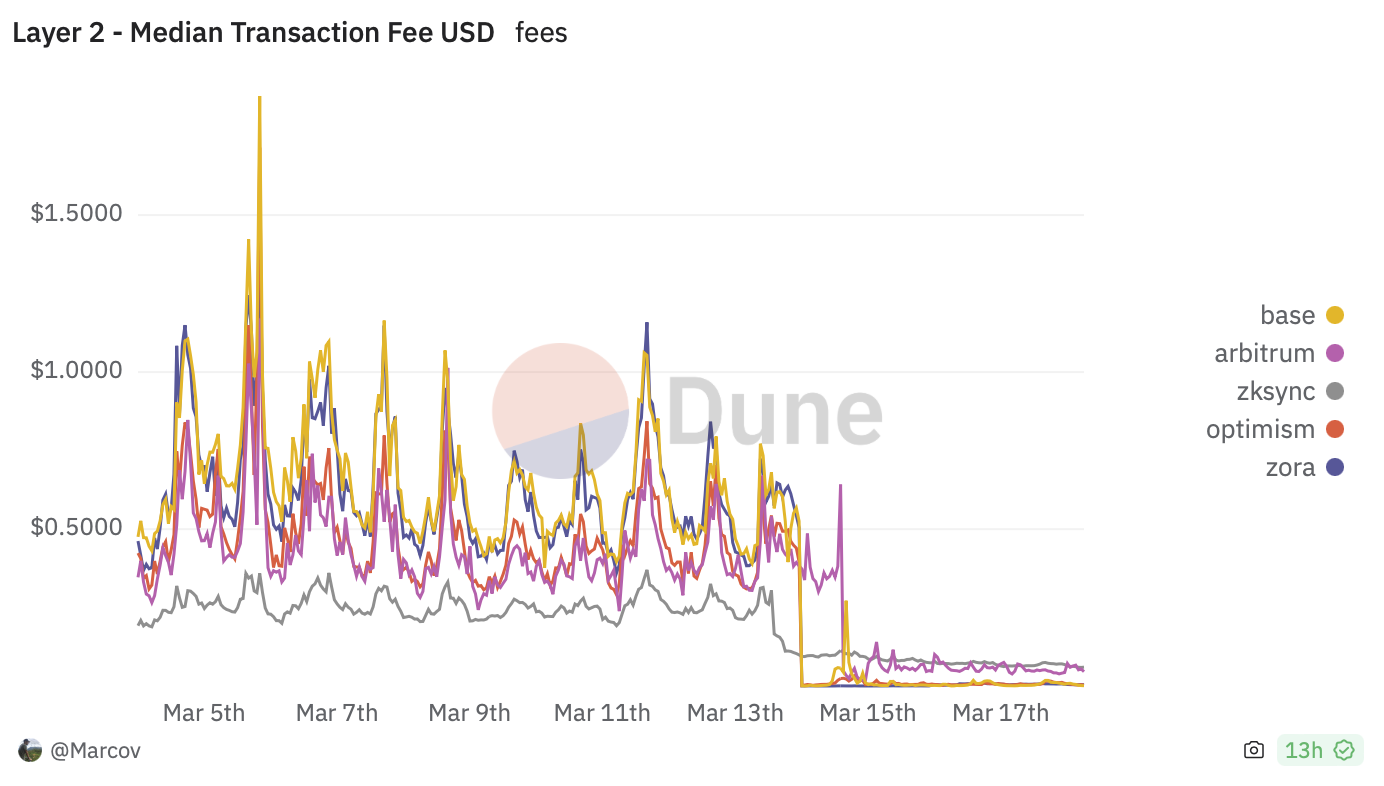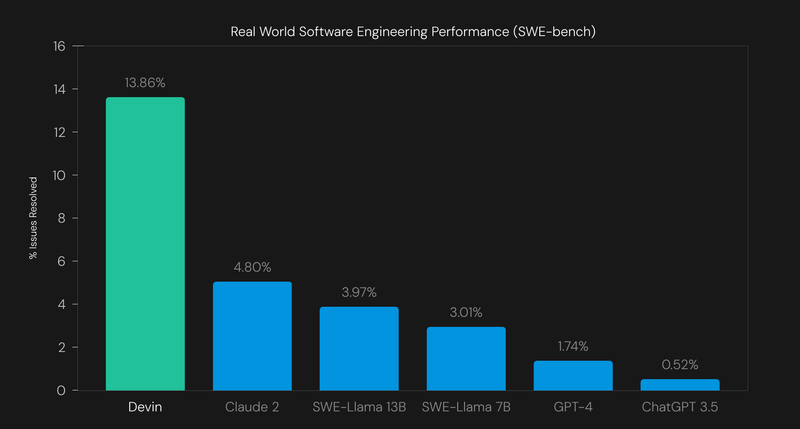#407: The Dencun Upgrade Is An Important Step Toward Scaling Ethereum’s Network, & More
1. The Dencun Upgrade Is An Important Step Toward Scaling Ethereum’s Network

Last week, the Ethereum networki underwent a significant technical upgrade called Dencun, or EIP 4844, that should reduce transaction fees for its Layer 2 solutions.ii Within three days of its implementation, all Layer 2 solutions, including Optimism and ZkSync, have benefited. The fees that Ethereum users now pay for transactions on their Layer 2 blockchain solution of choice are 5 to 10 times lower than before the upgrade, as shown below.

Source: Dune Analytics. For informational purposes only and should not be considered investment advice or a recommendation to buy, sell, or hold any particular security or cryptocurrency. Past performance is not indicative of future results.
Sometimes called Protodanksharding in recognition of its two pioneering researchers, EIP-4844 has hit the first milestone in the Ethereum Foundation’s ambitious multi-year, four-phase roadmap. Its goal is to scale the technology for widespread adoption by increasing throughput from 100 to 100,000-500,000 transactions per second (TPS), a more than 1000-fold increase. EIP-4844 is paving the way for subsequent upgrades like Proposer/Builder Separation and Data Availability Sampling, culminating eventually in the final phase, Danksharding.
Although it has been the premier smart contract platform for developers and users globally, the Ethereum network is facing increasing competition from other smart contract platforms like Solana, whose input today is more than 2000 TPS. With the potential launch of an Ethereum ETF within the year, attention on Ethereum is expected to intensify, likely drawing more retail users to the platform. This increased focus also may heighten comparisons with other high-throughput platforms like Solana. The Dencun upgrade is an important step toward scaling Ethereum, attracting more users, and retaining market share.
2. Is Starship One Step Closer To Mars?

Rarely does an object the size of a skyscraper launch into space, but that’s what happened as SpaceX completed Starship’s third test flight last week. While the spacecraft and booster failed to splashdown gently, the test flight hit many of SpaceX’s milestones and shifted the "if" to "when" Starship will function fully. Importantly, based on the orbital velocity achieved, the test flight suggested that SpaceX could use expendable Starships to deploy larger Starlink satellites.
The day after its launch, Elon Musk tweeted that the Starship’s max payload in expendable mode is ~200 tons.iii According to payload analyst Jack Kuhr, the cost to build a Starship is ~$100 million.iv If both statistics are correct, then its cost to reach space is $500/kg, or roughly half that of SpaceX‘s reusable Falcon 9.v Thus far, no other company has come close to replicating the Falcon 9. Starship should push SpaceX even further ahead of the competition.
3. Cognition Labs’ Devin AI Agent Outperforms LLMs On Complex, Real-World Engineering Tasks

Last week, Cognition Labs released Devin, an AI agent that can write software autonomously with its own code editor, browser, and planning tools. While most large language models (LLMs) and generative coding assistants can produce simple applications or short snippets of code, rarely can they code and debug more complex software products for implementation in production use cases. On that score, Devin appears to be uniquely capable.
To quantify Devin's improvements over foundation models, we can compare their relative performance on the SWE-bench (“Real World Software Engineering” benchmark). SWE-bench asks AI agents to resolve real-world bugs and tasks in 12 openly available Python repositories. On that basis, Devin scored 13.86% compared to Claude 2's 4.8% and GPT-4's 1.74%, as shown below. Unlike Devin, the other LLMs required human intervention to identify which repository files contained errors.
As generative AI's ability to code autonomously improves, the amount of software available to enhance our daily lives is likely to expand rapidly.

Source: Cognition Labs 2024.vi For informational purposes only and should not be considered investment advice or a recommendation to buy, sell, or hold any particular security or cryptocurrency. Past performance is not indicative of future results.
4. The CAR-T Cell Therapy Market Seems Poised For Expansion Into Autoimmune Disorders
In 2021, CAR-T cell therapy gained acclaim after scientists demonstrated complete remission rates in the 62% to 95% range when used to target CD19 in patients whose acute lymphoblastic leukemia had relapsed.vii Last year, ARK highlighted the story of Alyssa, a 13-year-old girl in the UK who had been diagnosed with T-Cell Acute Lymphoblastic Leukemia, a type of cancer that affects the immune system. CAR-T cell therapy treatment wiped out Alyssa’s cancer. In one month, she was in remission and, in six months, cancer-free.
Now, new research is highlighting the potential for CAR-T cell therapy to expand beyond cancer. In February, scientists from the Friedrich-Alexander University Erlangen-Nürnberg published a study on the potential of CAR-T cell therapy in autoimmune disorders. These diseases currently afflict 50 million Americans, 75% of whom are women, indicating a significant unmet need.
CAR-T cell therapy is not without risks. Since 2017, the FDA has approved six autologousviii -T cell therapies to treat more than 20,000 people.ix In December, the FDA announced an investigation into the secondary malignancies in patients who received autologous CAR-T cell immunotherapies. Quickly, however, it determined that the benefits in cancer therapy outweigh the risks. That said, the risk-benefit analysis for autoimmune diseases could be different.
Our research suggests that clinical trials for CAR-T cell therapy in autoimmune diseases will proliferate. We could see novel forms of delivery that lessen the potential risk associated with the lenti viral vectors thought to cause secondary malignancies.
i Ethereum is a network of computers all over the world that follow a set of rules called the Ethereum protocol. The Ethereum network acts as the foundation for communities, applications, organizations, and digital assets that anyone can build and use.
ii Ethereum Layer 2s are frameworks and protocols developed to enhance the Ethereum network's ability to process transactions, reduce transaction fees, and increase throughput, all while maintaining the network's core security principles.
iii Musk, E. 2024. “Max payload of Starship V1 in expendable mode…” X.
iv Kuhr, J. 2024. “Payload Research: Detailing Artemis Vehicle R&D Costs.” Payload.
v Based on ARK’s estimate of the cost of a reusable Falcon 9.
vi Wu, S. 2024. “Introducing Devine, the first AI software engineer.” Cognition.
vii Frey, N. V. 2021. “Relapsed ALL: CAR T vs transplant vs novel therapies.” Hematology Am Soc Hematol Educ Program.
viii Moffitt Cancer Center. 2022. “Autologous vs. Allogeneic CAR T.”
ix Boettner, B. 2023. “CAR-T cell cancer immunotherapy gets personal.” Wyss Institute.


